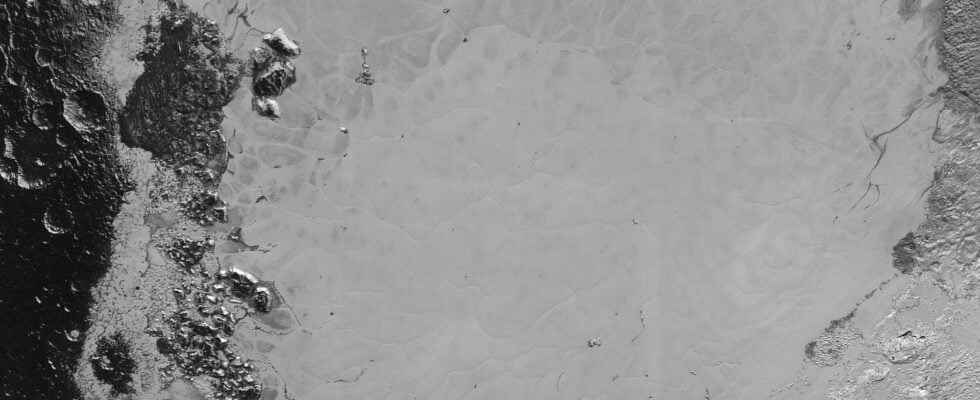Studying Sputnik Planitia, a large impact crater filled with ice of nitrogen, methane and carbon monoxide, the New Horizons probe observed polygonal shapes separated by small hollows on the surface of the ice. After several hypotheses that do not reach consensus, a team of French and British scientists suggests that convection movements, originating in the sublimation of nitrogen, could create these forms on the surface.
You will also be interested
[EN VIDÉO] New Horizons flies over the frozen surface of Pluto During its flight over Pluto, the New Horizons probe captured very detailed images of its surface. They allowed this video montage, where we discover for the first time the region of Tombaugh, the mountains of Norgay as well as the frozen Spoutnik plain.
Located in the kuiper belt, Pluto is a telluric body with a very cold surface (-236 ° C on average), due to its very great distance from the Sun (on average 39.5 AU, or nearly 6 billion kilometers). Its surface is covered with ices of water, methane,nitrogen and of carbon monoxide. This dwarf planet also has a atmosphere composed of nitrogen, methane and carbon monoxide, a composition very close to that of surface ice. This atmosphere is very thin: the pressure on Pluto’s surface is only 15 µbars, or 100,000 times less than on Earth.
Interactions between surface ice and the atmosphere
The link between surface ice and the Plutonian atmosphere seems relatively well established: due to the action of the solar radiation on the surface of Pluto, part of the ice present will sublimate (passage of the state solid to thegaseous state), enriching the Plutonian atmosphere with initially frozen compounds. Conversely, when the temperature drops, part of the atmosphere will condense to form ice on the surface. These sublimation / condensation cycles are also strongly impacted by the strong eccentricity of the’orbit plutonian.
Amazing shapes on the ice surface of Sputnik Planitia
Since his first flyover of Pluto in 2015, the New horizons was able to capture images of many regions on the surface of the dwarf planet, including Sputnik Planitia, a large impact basin that was later said to have been filled with ices of nitrogen, methane, and carbon monoxide in minor proportions.
What attracted theeye scientists are the scars present on the surface of this mixture of ice, in the form of flat polygons delimited by small narrow hollows. Several hypotheses had already been proposed to explain these characteristics (flow of heat, temperature gradient in the ice layer), without any one being able to explain such a surface topography.
Sublimation of nitrogen involved
Thanks to many numerical simulations, the research team claims to have understood the mechanism behind these forms: due to the sublimation – transition from solid to gaseous state, without passing through the state liquid – nitrogen on the surface of Pluto, local cooling causes convection movements in the layers of ice, thus reshaping its surface. The layer of ice would therefore be perpetually remodeled, according to the cycles of sublimation / condensation on the surface of Pluto.
According to the scientists of the study, such a dynamic could be observed on other regions of the surface of Pluto, or on the surface of other cold bodies, such as Triton (satellite of Neptune), or Eris (one of the largest bodies of the kuiper belt).
Interested in what you just read?
.
fs3
